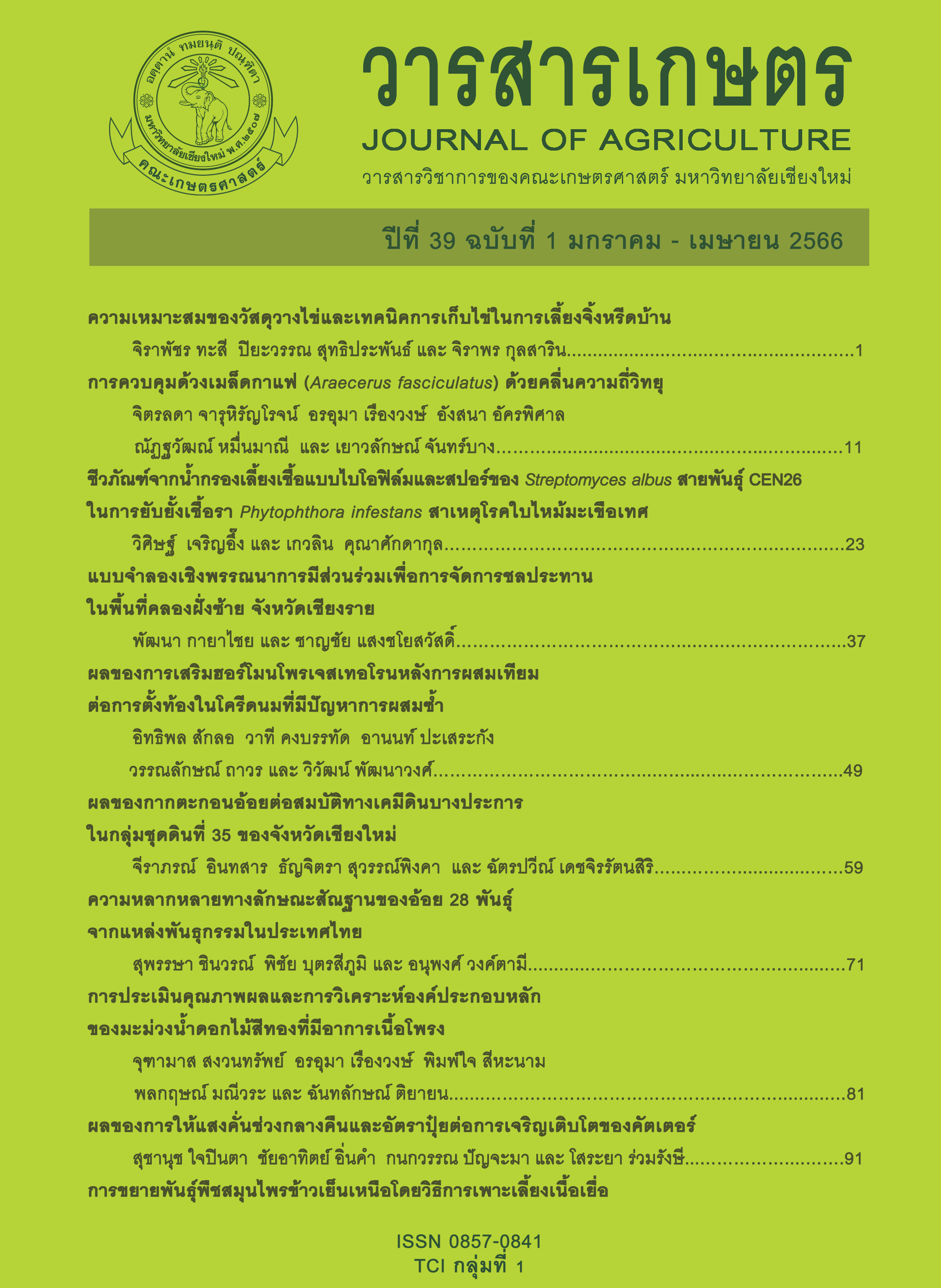แบบจำลองเชิงพรรณนาการมีส่วนร่วมเพื่อการจัดการชลประทานในพื้นที่คลองฝั่งซ้าย จังหวัดเชียงราย
Main Article Content
บทคัดย่อ
การศึกษาครั้งนี้มีวัตถุประสงค์เพื่อบ่งชี้ถึงถ้อยแถลงปัญหาของระบบชลประทาน ณ พื้นที่คลองฝั่งซ้ายในจังหวัดเชียงราย ซึ่งพืชหลักที่เพาะปลูกในพื้นที่ชลประทานนี้ คือ ข้าว โดยผ่านการวิเคราะห์แผนภาพเชิงพรรณนาของกระบวนการมีส่วนร่วม ภายใต้หลักแนวคิดเชิงระบบของ Chambers (1988) และ Small and Svendsen (1992) แผนภาพเชิงพรรณนาของกระบวนการมีส่วนร่วมแสดงถึงความสัมพันธ์ของระบบชลประทานในพื้นที่ศึกษา โดยส่วนประกอบของระบบชลประทานถูกจัดหมวดหมู่เป็น สี่ หมวด (หมวดเทคนิค หมวดเกษตร-ชลประทาน หมวดสถาบัน และ หมวดการเงินงบประมาณ) ซึ่งข้อมูลที่เกี่ยวข้องสำหรับการศึกษาได้ถูกรวบรวมผ่านกระบวนการมีส่วนร่วมที่เรียกว่า “การวิเคราะห์ชุมชนแบบมีส่วนร่วม” ซึ่งข้อมูลเชิงคุณภาพและข้อมูลเชิงปริมาณถูกรวบรวมโดยผ่านกลุ่มผู้มีส่วนเกี่ยวข้อง ได้แก่ กลุ่มเจ้าหน้าที่รัฐ (11 คน) และสมาชิกกลุ่มผู้ใช้น้ำ (22 คน) ในปี พ.ศ. 2563 โดยแผนภาพเชิงพรรณนาของกระบวนการมีส่วนร่วมได้อธิบายถึงถ้อยแถลงปัญหาของระบบชลประทานในฤดูฝน และ ฤดูแล้ง ที่ว่าปัญหาหลัก คือ ในฤดูฝน น้ำท่วมคลองส่งน้ำหลักเป็นปัญหาหลัก โดยมีสาเหตุหลายสาเหตุ เช่น ปริมาณน้ำฝนที่มากในช่วงเดือนกรกฎาคมถึงเดือนสิงหาคมทำให้ปริมาณน้ำที่ไหลเข้าด้านข้างของคลองส่งน้ำหลักในฤดูฝนจากร่องน้ำตามธรรมชาติ ความจุปริมาณน้ำของคลองส่งน้ำหลักในบริเวณปลายคลองส่งน้ำ และ ระบบระบายน้ำที่ไม่มีประสิทธิภาพ ส่งผลให้เกิดน้ำท่วมหนักในบริเวณปลายคลองส่งน้ำ สำหรับฤดูแล้ง ปัญหาหลัก คือ การขาดแคลนน้ำสำหรับการเกษตร โดยมีสาเหตุมาจากสามปัจจัยหลัก ได้แก่ พื้นที่ปลูกข้าวที่มากเกินไปโดยไม่สัมพันธ์กับปริมาณน้ำชลประทาน การจัดการชลประทานที่ไม่ดีเนื่องจากความอ่อนแอขององค์กรของผู้มีส่วนเกี่ยวข้องกับการใช้น้ำและประสิทธิภาพของระบบการกระจายน้ำที่ไม่ดี
Article Details

อนุญาตภายใต้เงื่อนไข Creative Commons Attribution-NonCommercial-NoDerivatives 4.0 International License.
เอกสารอ้างอิง
Allen, R.G., L.S. Pereira, D. Raes and M. Smith. 1998. Crop Evapotranspiration: Guidelines for Computing Crop Water Requirements. FAO Irrigation and Drainage Paper No. 56. FAO. Rome. 300 p.
Cavestro, L. 2003. P.R.A.- Participatory rural appraisal: Concepts methodologies and techniques. M.A. Thesis. Universita degli Studi di Padova, Padova. 38 p.
Chambers, R. 1988. Managing Canal Irrigation: Practical Analysis from South Asia. Cambridge University Press. Cambridge. 279 p.
Chittaladakorn, S. 2013. Decision Support System for Water Resources Engineering Management. Kasetsart University Press, Bangkok. 503 p. (in Thai)
FAO. 1997. Modernization of Irrigation Schemes: Past Experiences and Future Options. Water Report Series 12. FAO Regional Office for Asia and the Pacific. Bangkok. 258 p.
Hare, M. 2011. Forms of participatory modelling and its potential for widespread adoption in the water sector. Environmental Policy and Governance 21(6): 386-402.
Small, L.E. and M. Svendsen. 1992. A framework for assessing irrigation performance. Irrigation and Drainage Systems. 4: 283-312.
Smyth, D.S. and P.B. Checkland. 1976. Using a systems approach: The structure of root definitions. Journal of Applied Systems Analysis 5: 75-83
Wongprasittiporn, C. 2005. Large rice-based irrigation systems in Thailand. pp. 136-140. In: Proceedings of the Regional Workshop on the Future of Large Rice-Based Irrigation Systems in Southeast Asia. Ho Chi Minh City, Viet Nam.
Wongprasittiporn, C. 2007. The Future of Large Rice-based Irrigation System in Southeast Asia. FAO Regional Office for Asia and the Pacific. Bangkok. 119 p.
Wongtragoon, U., N. Kubo and H. Tanji. 2010. Performance diagnosis of Mae Lao Irrigation Scheme in Thailand. (I) Development of unsteady irrigation water distribution and consumption model. Paddy and Water Environment 8(1): 1-13.


